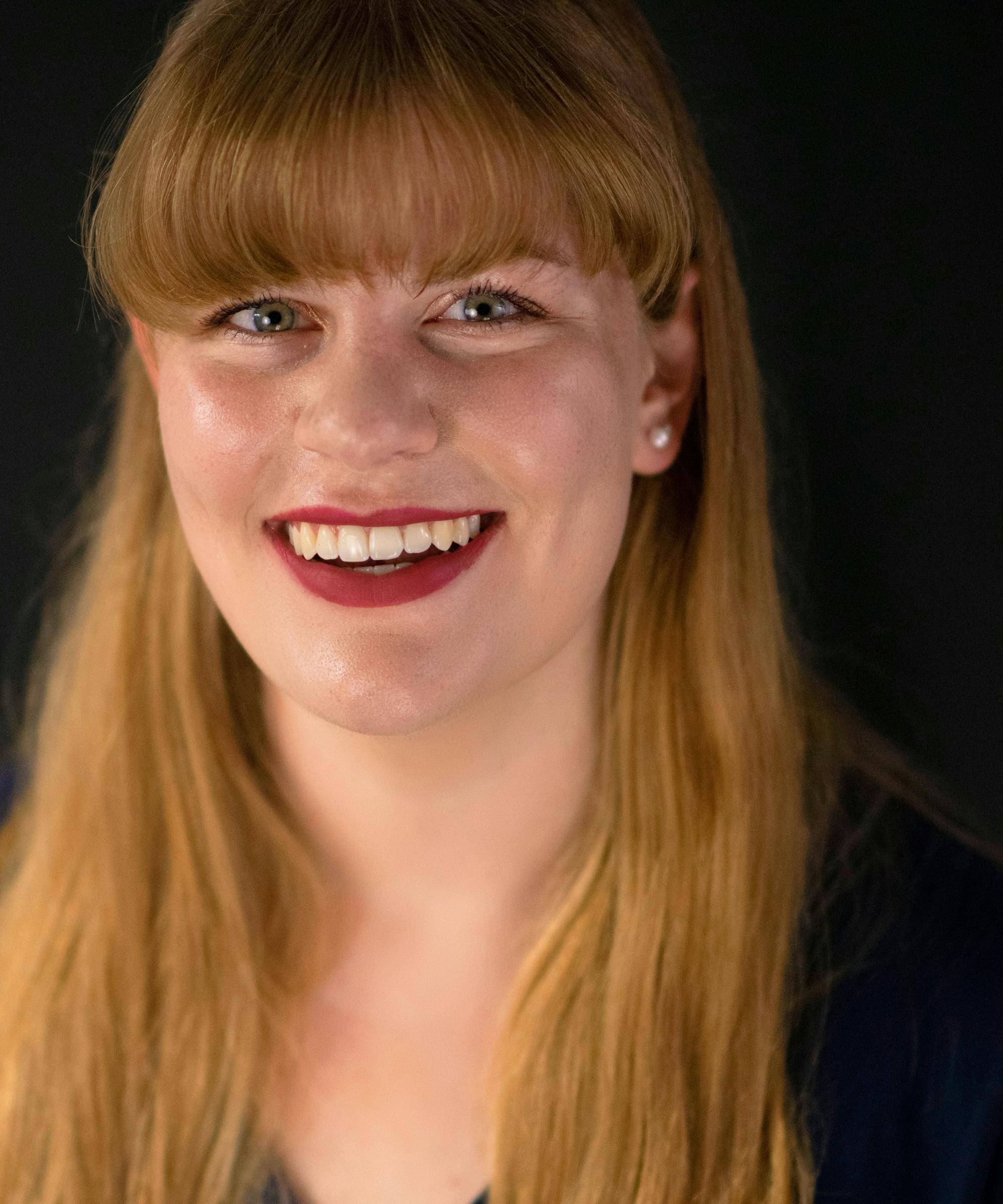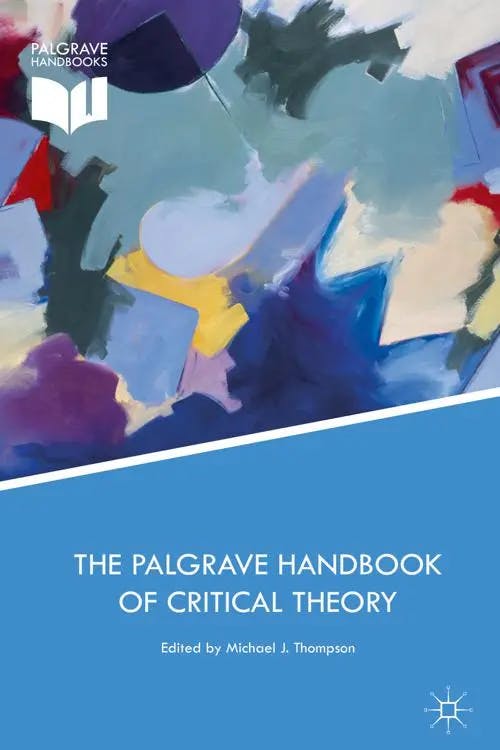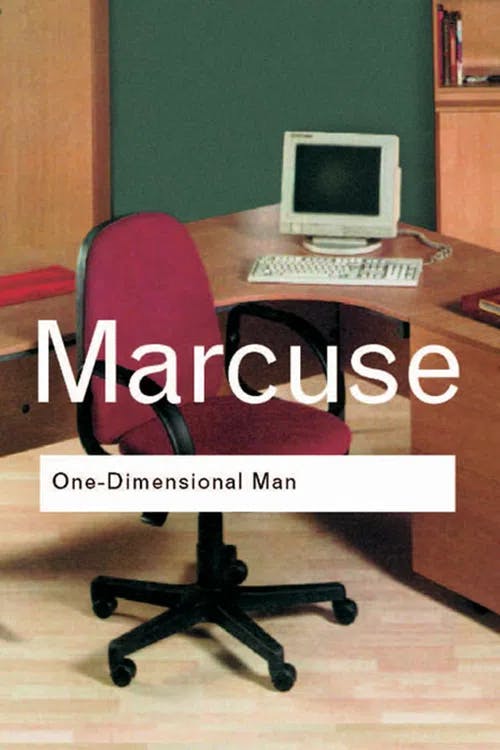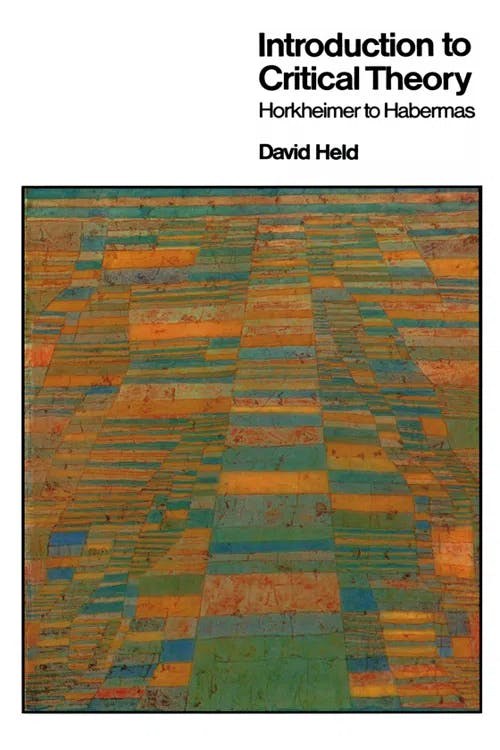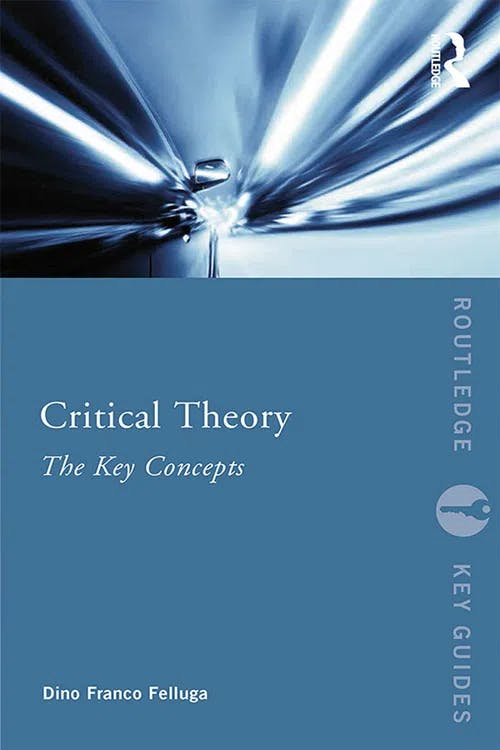What is Critical Theory?
MSt, Women's, Gender & Sexuality Studies (University of Oxford)
Date Published: 25.04.2023,
Last Updated: 14.11.2023
Share this article
Defining critical theory
Critical theory, broadly understood, is any approach to the study of society and culture that aims to expose, critique, and ultimately combat oppressive power structures. In his introduction to The Palgrave Handbook of Critical Theory, Michael J. Thompson writes that critical theory is a “form of social criticism” which can be viewed “as a tradition, as a set of questions, or as a series of distinct thinkers” (2017). Thompson writes,
it was a form of thinking that is designed not only to comprehend, but also to transform: its purpose is to change not only our knowledge of the objective world — of society, of institutions, of culture, and so on — but simultaneously the nature of the subject in a practical sense. [...]
The key insight of a critical theory of society is therefore not meant to impose some set of a priori values and ideals onto the social world, but to unravel the contradictions that already exist within it; to make evident an emancipatory insight into the very fabric of what we take as given, as basic to our social world. (2017)
Edited by Michael J. Thompson
it was a form of thinking that is designed not only to comprehend, but also to transform: its purpose is to change not only our knowledge of the objective world — of society, of institutions, of culture, and so on — but simultaneously the nature of the subject in a practical sense. [...]
The key insight of a critical theory of society is therefore not meant to impose some set of a priori values and ideals onto the social world, but to unravel the contradictions that already exist within it; to make evident an emancipatory insight into the very fabric of what we take as given, as basic to our social world. (2017)
Critical theory thus embraces a host of philosophies and methodologies under its umbrella — from queer theory to new historicism, from Lacanian psychoanalysis to postcolonialism.
Critical theory did not begin with this broad definition. The term first described the project of thinkers associated with the Institute for Social Research at Goethe University Frankfurt, commonly called the Frankfurt School. German philosopher and Institute director Max Horkheimer coined the term “Critical Theory” in his essay “Traditional and Critical Theory” (1937). In this guide, we’ll use Critical Theory (capitalized) to designate the specific theories associated with the Frankfurt School and their direct respondents, like Jürgen Habermas, while “critical theory” (not capitalized) will indicate the broader, umbrella term.
We can understand the goal of critical theory by breaking down the term itself. “Theory,” or a system of explanation/interpretation, has become an essential part of cultural analysis and academic life. Theoretical tools help us analyze texts, societies, and structures of power. The “critical” in “critical theory” signals its political consciousness and emphasis on critique. For critical theorists, no criticism can be entirely objective or value-free and scholarship should not be kept separate from the political world.
Critical theory’s power lies in its engagement with this political world. Instead of being limited to a vacuum of aesthetic valuation, critical theory sees any interpretive activity as being part of larger systems and conversations. In fact, many critical theorists argue that aesthetics themselves are shaped by power and politics.
This guide provides a summary of the origins of critical theory, from Marxism through the Frankfurt School and beyond. We conclude with an overview of the key developments in critical theory leading up to the present day.
Origins of critical theory: Marxism
Marxism is an important origin point for critical theory. Elements of Marxist analysis prefigured critical theory’s approach, and the Frankfurt School aimed to revise Marx’s ideas. Marxism remains a theory that is used and reinterpreted to critically examine society and culture today.
An element of Marxist thinking which particularly informs critical theory is the idea that society consists of infrastructure (an economic base) and superstructure. As Sim and Van Loon explain, “The superstructure comprises everything cultural — religion, politics, law, education, the arts, etc. — which is determined by a specific economy (slave-based, feudal, mercantile, capitalist etc.)” (2014). For strict Marxists, a society’s culture is determined entirely by its economy. The level of autonomy culture can have from its society’s economic base remains a scholarly debate. (See our study guides on the culture industry and commodity fetishism for more on how critical theorists developed these ideas.)
Critical theory not only inherits an interest in this tension between autonomous and economically determined cultural production, but it also takes up Marx’s view of the text, any encoded production, as the site of this tension and a container of hidden meanings. Critical theory also shares Marxism’s transformative impulse: the belief that philosophy can not only examine the world but also change it.
Key figures in Critical Theory: Marx’s revisors, the Frankfurt School, and Habermas
Orthodox Marxism faced a crisis at the beginning of the twentieth century. In The Communist Manifesto (1848, [2017]), Marx and Friedrich Engels had predicted that a proletarian uprising leading to capitalism’s destruction was imminent. Yet, in the aftermath of the Russian Revolution and early twentieth-century political developments, theorists recognized that these socialist movements had failed to materialize as Marx had predicted, and a new way of thinking was needed in order to adapt Marx to reality.
Four important thinkers — Karl Korsch, Georg Lukács, Antonio Gramsci, and Wilhelm Reich — answered this need with their own theories about the subject and society. In Marxism and Philosophy [1923, (2013)], Korsch argued that a critique of ideology was needed so that the working class could comprehend and reject the system in which they were embedded. Lukács agreed, and, in History and Class Consciousness [1923, [1972]), he argued that capitalism blocked revolutionary impulses through “reification,” or the process of making current systems seem natural. Gramsci theorized the concept of “hegemony,” that bourgeois ideas are embedded in culture. He proposed that dominant powers rely on “the deployment of particular cultural norms and mindsets that would dull and inhibit critical consciousness, thereby short-circuiting the radical activity of the working class” (Thompson, 2017). Reich aimed to unify the theories of Marx and Freud by proposing that fascism’s appeal relied not on economic factors but on personal repression:
the repression of primitive drives and needs (specifically the moral inhibition of the natural sexuality of the child) through the institutions of society — from the family through the schools and the workplace — posits an authoritarian structure that inhibits the will to freedom and instead instills a ‘fear of freedom’ and the embrace of reactionary politics. (Thompson, 2017)
Breaking with orthodox Marxism, these four thinkers opened the door for critical theorists to engage in a “critique of culture, a critique of the legitimating institutions, the logics of modern technological forms of life, communication and production, no less than the new forms of state and legal institutions and the structure and dynamics of the family and modern personality” (Thompson, 2017).
The Frankfurt School synthesized the insights of these revisors of Marx into a coherent system and research paradigm: Critical Theory. Max Horkheimer contrasted Critical Theory with “traditional theory”; while “traditional theory” aimed to describe, Critical Theory sought to describe, evaluate, and transform. Critical Theory is, for Horkheimer, inherently skeptical; he writes in “Traditional and Critical Theory,”
[Critical Theory] is suspicious of the very categories of better, useful, appropriate, productive, and valuable, as these are understood in the present order, and refuses to take them as nonscientific presuppositions about which one can do nothing. (1937, [1975])
Combining methods from the social sciences, philosophy, psychoanalysis, and literary studies, Horkheimer and his fellow thinkers — Theodor Adorno, Herbert Marcuse, Walter Benjamin, and others — began to ask new questions about social structures, aesthetics, popular culture, and power. This group developed theories foundational to twentieth-century thought, understanding capitalism not only as a system of production but also a normative force; critiquing ideology as working against emancipatory potential; and viewing the family as the first site of authoritarian conditioning.
Marcuse begins his influential work One-Dimensional Man (1964, [2013]) with these evocative lines:
A comfortable, smooth, reasonable, democratic unfreedom prevails in advanced industrial civilization, a token of technical progress. Indeed, what could be more rational than the suppression of individuality in the mechanization of socially necessary but painful performances [...].
Herbert Marcuse
A comfortable, smooth, reasonable, democratic unfreedom prevails in advanced industrial civilization, a token of technical progress. Indeed, what could be more rational than the suppression of individuality in the mechanization of socially necessary but painful performances [...].
Marcuse goes on to explore how radical potential was stifled as “normative concepts such as freedom were being collapsed into the very ideological structures of the techno-industrial system” (Thompson, 2017).
Aesthetics was an important area of focus for Critical Theory. In the landmark essay “The Work of Art in an Age of Mechanical Reproduction” (1936), reprinted in Illuminations (1968), Benjamin proposed the concept of an artwork’s “aura,” the trace of the artist’s labor and the original work’s unique presence in time and space, both of which cannot be replicated through reproduction. The “aura” is the reason why one would pay thousands of dollars for an original Rembrandt but not for a reproduction.
One of the most influential works produced by the Frankfurt School is Horkheimer and Adorno’s Dialectic of Enlightenment (1947, [2002]). Horkheimer and Adorno argue that the “reason” associated with Western Enlightenment tends toward self-destruction. They propose that this destruction results from a dialectic between external nature and society, between myth and enlightenment, ideas that are dialectical but, paradoxically, not irreconcilable. (See our study guide on the Culture Industry for more on Adorno and Horkheimer’s theories, especially in relation to the question of how culture is economically determined.)
By the late 1960s, Critical Theory was beginning to lose the practical–political focus with which it had been founded. In response, Jürgen Habermas proposed a new path for Critical Theory in Knowledge and Human Interests (1968, [2015]). Habermas argued that Horkheimer and Adorno collapsed reason with instrumental rationality. He believed that reason must be reconstructed through intersubjective, communicative relationships and practices rather than individual-centered consciousness. Focusing on structures of language and communication through speech acts, Habermas developed a new framework called “discourse ethics” which not only critiqued existing structures but also proposed the possibility of consensus through discourse. This development endowed Critical Theory with a new emphasis on language and communication.
Though each Critical Theorist developed their own ideas, David Held writes,
The motivation for this enterprise appears similar for each of the theorists — the aim being to lay the foundation for an exploration [...] of questions concerning the conditions which make possible the reproduction and transformation of society, the meaning of culture, and the relation between the individual, society and nature. While there are differences in the way they formulate questions, the critical theorists believe that through an examination of contemporary social and political issues they could contribute to a critique of ideology and to the development of a non-authoritarian and non-bureaucratic politics. (2013)
David Held
The motivation for this enterprise appears similar for each of the theorists — the aim being to lay the foundation for an exploration [...] of questions concerning the conditions which make possible the reproduction and transformation of society, the meaning of culture, and the relation between the individual, society and nature. While there are differences in the way they formulate questions, the critical theorists believe that through an examination of contemporary social and political issues they could contribute to a critique of ideology and to the development of a non-authoritarian and non-bureaucratic politics. (2013)
The Critical Theorists asked important questions about methodology, self-reflection, and the process of critique itself, situating power instead of truth as the primary focus for theoretical analysis going forward (Tallack, 2014).
Developments in critical theory up to the present day
While the theories of the Frankfurt School and Habermas continue to influence critical theory, its reach has expanded significantly. As Dino Franco Felluga writes in Critical Theory: The Key Concepts, critical theory has become
a general term for the theoretical analysis of culture at large, thus bringing under its umbrella a tradition of thinking that extends from the structuralists of the modern period to the deconstructionist and postmodern theorists of the last 50 years. In this sort of critical theory, the aim is not so narrowly specific social change through the analysis of class antagonism than it is the examination of the larger linguistic and ideological structures by which we make sense of, while thus ideologically constructing, the world around us. (2015)
Dino Franco Felluga
a general term for the theoretical analysis of culture at large, thus bringing under its umbrella a tradition of thinking that extends from the structuralists of the modern period to the deconstructionist and postmodern theorists of the last 50 years. In this sort of critical theory, the aim is not so narrowly specific social change through the analysis of class antagonism than it is the examination of the larger linguistic and ideological structures by which we make sense of, while thus ideologically constructing, the world around us. (2015)
Critical theory and literary studies
Critical theory has had a significant influence on literary studies. Roland Barthes, A.J. Greimas, and Tzevetan Todorov studied literature as a distinct discourse and helped develop, along with Vladimir Propp and Claude Lévi-Strauss, “narratology,” an approach which breaks down narratives into universal patterns, codes, and tropes that are repeatedly reused. For more, we recommend Wolf Schmid’s Narratology (2010) and Narratology (2014), edited by Susana Onega and José Angel García Landa. Mikhail Bakhtin argued that all narratives exist without fixed meaning and are open to multiple interpretations, and he proposed that literature is deeply “intertextual,” or constantly engaged with other texts (an idea developed further by Julia Kristeva). From these strands of critical theory grew reader-response or reception theory, which aimed to understand how the identity, place, time, and culture of a reader affects the reading experience and their interpretation of the text. Meanwhile, new historicists like Stephen Greenblatt and cultural materialists such as Alan Sinfield and Jonathan Dollimore argued that artistic production was influenced by the power struggles of its historical moment. For more on these theories, see Greenblatt’s Learning to Curse (1990, [2015]), Catherine Gallagher and Greenblatt’s Practicing New Historicism (2020), Dollimore’s Radical Tragedy (2010), and Sinfield’s Shakespeare, Authority, Sexuality (2006).
Significant French philosophers: Lacan, Derrida, Foucault
Another important development in critical theory is Jacques Lacan’s reinterpretation of psychoanalysis, especially his ideas of the Imaginary and Symbolic realms. Infants begin in the Imaginary realm, the pre-self-conscious state, before entering the “mirror stage,” or the first moment of self-recognition (when a child recognizes their reflection). After about 18 months, according to Lacan, we enter the Symbolic stage, the realm of social language. Feminist theorists were particularly interested in these stages in terms of learned gender. The Imaginary realm is associated with the mother, while the Symbolic realm is associated with the father, a realm of patriarchal language which oppresses women. (See Elizabeth Grosz’s Jacques Lacan: A Feminist Introduction [2002] for more on feminist uses for Lacan’s ideas.)
Another influential French critical theorist is Jacques Derrida. Derrida is known for “deconstruction,” his proposed method of critique for literary and philosophical texts as well as political systems. Responding to structuralism’s dependence on binary oppositions, Derrida argued that the binaries to which Western thinking gravitates (white/black, masculine/feminine, conscious/unconscious, normal/abnormal) are actually hierarchies, skewed such that one side of the binary is deemed superior to the other. Derrida aimed to erase that boundary while questioning the hierarchy itself, revealing it as constructed.
Michel Foucault also responded to structuralist binaries and made essential contributions to critical theory. Drawing upon Gramsci’s ideas of hegemony, Foucault proposed that systems of power rely on the marginalization and exclusion of certain groups in the name of “order.” These unconscious hierarchies pervade society; knowledge means categorization, power depends upon marginalization, and order relies on systemized control (Sim and Van Loon, 2014). In History of Madness (1961, [2013]), Foucault examines the removal of the mentally ill (anyone whose behavior deviated from societal norms) to asylums. In Discipline and Punish (1975, [1995]) and The Birth of the Clinic (1963, [2012]), Foucault examines the prison system and the medical system, respectively, as their own sites of imposed order upon individuals and marginalization of those who do not conform. In The Archaeology of Knowledge (1969, [2012]), Foucault provides an overview of his methodology, which aimed to reveal the suppressed discourses of Western society through historical research, or “archaeologies.”
Twentieth-century “deaths”
Twentieth-century critical theorists proclaimed the “death” of many concepts. Roland Barthes declared the “death of the author” in his landmark 1967 essay of the same name (reprinted in Authorship [1995]), and Foucault reconsidered this idea in “What is an Author?” (1969). Barthes was particularly interested in how the relationship between the writer and the reader had changed (with the reader taking on a more active role), while Foucault was interested in issues of the complex relationship between the author and the text they create. The “death of man,” or the death of the Enlightenment-era subject, was also heralded thanks to the effects of critical theory: we cannot be self-conscious subjects with the power to dominate the world around us if we are, in fact, controlled by systems and unconscious drives. New materialism and posthumanism argued that the Enlightenment’s ideal “man” had always excluded many categories of human, and that the very boundary between human and inhuman is more porous than we may think. Francis Fukuyama declared the “death of history” with the fall of the Soviet Union, while Mark Fisher’s “hauntology” declared a death of the future.
Identity and interdisciplinary studies
While the original Critical Theorists focused on capitalism, class, and consumerism, later scholars have expanded those ideas to examine different reified structures of power. Feminism, queer theory, postcolonialism, and related theories — like gender performativity and intersectionality — investigate how identities are constructed, maintained, and hierarchized by structures around us. The relationship to critical theory is clear in the names of critical race theory and critical disability theory, both of which take up critical theory’s aims of exposing, critiquing, and combating power structures.
Critical theory has always been interdisciplinary, and it continues to propel scholarship across disciplines. Today’s literary theory is particularly reliant on critical theory. In Using Critical Theory (2020), Lois Tyson supplies a guide to incorporating theory into studies of literature. Critical theory’s interest in societal power structures makes it useful to the social sciences, as argued by the authors of the collection No Social Science without Critical Theory (2008), edited by Harry Dahms. Even science has been influenced by critical theory: Habermas, Critical Theory and Health (2013), edited by Graham Scambler, turns a critical eye to health and medical systems, and critical theorists are interested in issues of automation, artificial intelligence, and the internet (see David M. Berry’s Critical Theory and the Digital [2014] and Thomas Allmer’s Critical Theory and Social Media [2015] for just two examples).
Critical theory’s relevance today
The original suspicion with which Horkheimer endowed critical theory — its refusal to take for granted “categories of better, useful, appropriate, productive, and valuable” — is what keeps critical theory relevant today — and keeps scholars like Darrow Schecter questioning its relevance, at least in its original form. As Schecter writes in Critical Theory in the Twenty-First Century, to insist on the permanent relevance of the Frankfurt School “would be very much against the spirit of the thinkers in question as well as an inadequate response to current socio-economic and political realities” (2013).
However, critical theory’s commitment to critique, political awareness, and practical aspirations motivate meaningful scholarship even as specific theories, and societies, change. As Alan How neatly summarizes,
Critical Theory [...] always had a concern with how things had come to be the way they are and what they might be in the future, a concern with the wider truth or validity of what is currently the case. (Critical Theory, 2007)
Alan How
Critical Theory [...] always had a concern with how things had come to be the way they are and what they might be in the future, a concern with the wider truth or validity of what is currently the case. (Critical Theory, 2007)
This vision is why critical theory has significantly impacted the development of scholarly methods and why engaging with theory is an essential aspect of academic study today.
Further reading on Perlego
Critical Theory Today: A User-Friendly Guide by Lois Tyson
Engagements with Contemporary Literary and Critical Theory by Evan Gottlieb
Critical Theory and Society: A Reader by Stephen Eric Bronner and Douglas MacKay Kellner
The SAGE Handbook of Frankfurt School Critical Theory, edited by Beverley Best, Werner Bonefeld, and Chris O′Kane
Aspects of History and Class Consciousness, edited by Istvan Meszaros
Herbert Marcuse: A Critical Reader, edited by John Abromeit and W. Mark Cobb
What is critical theory?
Who are the key thinkers in Critical Theory?
What are some key examples of critical theory?
Bibliography
Allmer, T. (2015) Critical Theory and Social Media: Between Emancipation and Commodification. Routledge. Available at: https://www.perlego.com/book/1642396/critical-theory-and-social-media-between-emancipation-and-commodification-pdf.
Barthes, R. (1995) “The Death of the Author,” in Burke, S. (ed.) Authorship: From Plato to the Postmodern, Edinburgh University Press. Available at: https://www.perlego.com/book/1708663/authorship-from-plato-to-the-postmodern-a-reader-pdf
Benjamin, W. (1935, [2019]) “The Work of Art in the Age of Mechanical Reproduction,” in Illuminations. Translated by H. Zohn. Mariner Books. Available at: https://www.perlego.com/book/2418924/illuminations-essays-and-reflections-pdf.
Berry, D. (2014) Critical Theory and the Digital. Bloomsbury. Available at: https://www.perlego.com/book/818015/critical-theory-and-the-digital-pdf.
Dahms, H. (ed.) (2008) No Social Science without Critical Theory. Emerald Publishing Limited. Available at: https://www.perlego.com/book/387611/no-social-science-without-critical-theory-pdf.
Dollimore, J. (2010) Radical Tragedy: Religion, Ideology and Power in the Drama of Shakespeare and his Contemporaries. 3rd edn. Bloomsbury Publishing. Available at: https://www.perlego.com/book/2997100/radical-tragedy-religion-ideology-and-power-in-the-drama-of-shakespeare-and-his-contemporaries-pdf.
Felluga, D. F. (2015) Critical Theory: The Key Concepts. Routledge. Available at: https://www.perlego.com/book/1559357/critical-theory-the-key-concepts-pdf.
Foucault, M. (2013) The Archaeology of Knowledge. Translated by A. M. Sheridan Smith. 2nd edn. Routledge. Available at: https://www.perlego.com/book/1612530/archaeology-of-knowledge-pdf.
Foucault, M. (1963, [2012]) The Birth of the Clinic. Translated by A. M. Sheridan. 3rd edn. Routledge. Available at: https://www.perlego.com/book/1610931/the-birth-of-the-clinic-pdf.
Foucault, M. (1975, [1995]) Discipline and Punish: The Birth of the Prison. Translated by Sheridan, A. M. Vintage Books.
Foucault, M. (1961, [2013]) History of Madness. Translated by J. Murphy and J. Khalfa. Routledge. Available at: https://www.perlego.com/book/1615338/history-of-madness-pdf.
Foucault, M. (1976, [1990]) The History of Sexuality, Volume 1. Translated by R. Hurley. Vintage Books.
Foucault, M. (1969, [2018]) “What is an Author?,” in Steven, S. B. Modernity and Its Discontents. Yale University Press.
Gallagher, C. and Greenblatt, S. (2020) Practicing New Historicism. University of Chicago Press. Available at: https://www.perlego.com/book/1852579/practicing-new-historicism-pdf.
Greenblatt, S. (1990, [2015]) Learning to Curse. Routledge. Available at: https://www.perlego.com/book/1515269/learning-to-curse-essays-in-early-modern-culture-pdf.
Grosz, E. (2002) Jacques Lacan: A Feminist Introduction. Routledge. Available at: https://www.perlego.com/book/1620222/jacques-lacan-a-feminist-introduction-pdf.
Habermas, J. (1968, [2015]) Knowledge and Human Interests. Polity Press. Available at: https://www.perlego.com/book/1536103/knowledge-and-human-interests-pdf.
Held, D. (2013) Introduction to Critical Theory: Horkheimer to Habermas. Polity Press. Available at: https://www.perlego.com/book/1535679/introduction-to-critical-theory-horkheimer-to-habermas-pdf.
Horkheimer, M. (1937, [1975]) “Traditional and Critical Theory,” in Critical Theory: Selected Essays. Translated by M. O’Connell. Continuum.
Horkheimer, M. and Adorno, T. (1947, [2002]) Dialectic of Enlightenment. Translated by E. Jephcott. Stanford University Press. Available at: https://www.perlego.com/book/745055/dialectic-of-enlightenment-pdf.
How, A. (2017) Critical Theory. Bloomsbury. Available at: https://www.perlego.com/book/2990701/critical-theory-pdf.
Korsch, K. (1923, [2013]) Marxism and Philosophy. Translated by F. Halliday. Verso Books.
Lukács, G. (1923, [1972]) History and Class Consciousness: Studies in Marxist Dialectics. Translated by R. Livingstone. The MIT Press.
Marcuse, H. (1964, [2013]) One-Dimensional Man: Studies in the Ideology of Advanced Industrial Society. Routledge. Available at: https://www.perlego.com/book/1604665/onedimensional-man-studies-in-the-ideology-of-advanced-industrial-society-pdf.
Marx, K. and Engels, F. (1848, [2017]) The Communist Manifesto. Pluto Press. Available at: https://www.perlego.com/book/665627/the-communist-manifesto-pdf.
Onega, S., and García Landa, J. A. (eds.) (2014) Narratology. Routledge. Available at: https://www.perlego.com/book/1555786/narratology-an-introduction-pdf.
Schecter, D. (2013) Critical Theory in the Twenty-First Century. Bloomsbury. Available at: https://www.perlego.com/book/800787/critical-theory-in-the-twentyfirst-century-pdf.
Schmid, W. (2010) Narratology. Translated by A. Starritt. De Gruyter. Available at: https://www.perlego.com/book/652697/narratology-pdf.
Scambler, G. (2013) Habermas, Critical Theory and Health. Routledge. Available at: https://www.perlego.com/book/1597557/habermas-critical-theory-and-health-pdf.
Sim, S. and Loon, B. V. (2014) Introducing Critical Theory: A Graphic Guide. Icon Books.
Sinfield, A. (2006) Shakespeare, Authority, Sexuality: Unfinished Business in Cultural Materialism. Routledge. Available at: https://www.perlego.com/book/1602966/shakespeare-authority-sexuality-unfinished-business-in-cultural-materialism-pdf.
Tallack, D. (2014) Critical Theory: A Reader. Routledge. Available at: https://www.perlego.com/book/1546766/critical-theory-a-reader-pdf.
Thompson, M. J. (2017) The Palgrave Handbook of Critical Theory. Palgrave Macmillan. Available at: https://www.perlego.com/book/3507101/the-palgrave-handbook-of-critical-theory-pdf.
Tyson, L. (2020) Using Critical Theory: How to Read and Write About Literature. 3rd edn. Routledge. Available at: https://www.perlego.com/book/2194137/using-critical-theory-how-to-read-and-write-about-literature-pdf.
MSt, Women's, Gender & Sexuality Studies (University of Oxford)
Paige Elizabeth Allen has a Master’s degree in Women’s, Gender, and Sexuality Studies from the University of Oxford and a Bachelor’s degree in English from Princeton University. Her research interests include monstrosity, the Gothic tradition, illness in literature and culture, and musical theatre. Her dissertation examined sentient haunted houses through the lenses of posthumanism and queer theory.
